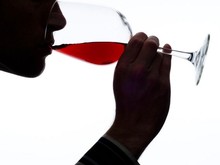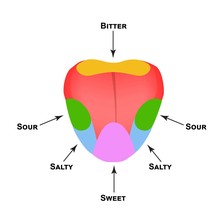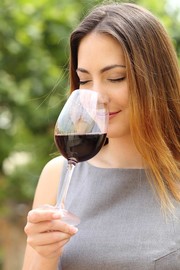Read Our
Winery Blog
"Tasting" Wine
“Tasting” Wine
 What is it about wines that allows them to be so fascinatingly complex? When it comes to consumable products there are few that receive the attention and analysis that wine does. From the beginner to the master sommelier, much of the fascination of wine tasting lies in the discovery of unique flavor profiles that are often specific to the person on the receiving end of that glass of fine wine. Before we meander down the path of complexity, it is important to note how complexity is experienced.
What is it about wines that allows them to be so fascinatingly complex? When it comes to consumable products there are few that receive the attention and analysis that wine does. From the beginner to the master sommelier, much of the fascination of wine tasting lies in the discovery of unique flavor profiles that are often specific to the person on the receiving end of that glass of fine wine. Before we meander down the path of complexity, it is important to note how complexity is experienced.

There are a small percentage of the population that are on the low end on the number of taste-buds spectrum. They are challenged more greatly because not only do they have fewer receptors to capture the sensory experience, but they by the same nature have fewer receptors to detect unpleasant elements. In general, this category finds most things taste fine, and need to be coaxed into searching for complexity, but with training tasting skills can be honed and refined.
 The average person is the ideal consumer. These are the tasters that can study, and practice, practice, practice in order to fully appreciate all the glorious flavors and sensations that wine has to offer. Here lie the true aficionados, constantly searching for the next great wine that will create lasting memories for them, and willing to pursue that quest until the end of time. They are able to identify flaws, yet understand the difference between something being bad and something they do not like.
The average person is the ideal consumer. These are the tasters that can study, and practice, practice, practice in order to fully appreciate all the glorious flavors and sensations that wine has to offer. Here lie the true aficionados, constantly searching for the next great wine that will create lasting memories for them, and willing to pursue that quest until the end of time. They are able to identify flaws, yet understand the difference between something being bad and something they do not like.
 Then there are the “cursed”, the hyper tasters. These are the poor souls that have more taste buds than the rest of us, and those taste buds are very sensitive. Left untrained, these are the most critical of tasters and the bane of winemakers. To them they can either love something or hate something uncompromisingly. They may discover the most exquisite flavor of Wiśnia Nadwiślanka (Eastern European cherry) and find it divine, but then the slightest hint of Havana cigar tobacco triggers a negative response they are unable to escape and so they dislike the wine. As there is simply no such thing as the “perfect wine” they wind up identifying the faults more than they enjoy the glories.
Then there are the “cursed”, the hyper tasters. These are the poor souls that have more taste buds than the rest of us, and those taste buds are very sensitive. Left untrained, these are the most critical of tasters and the bane of winemakers. To them they can either love something or hate something uncompromisingly. They may discover the most exquisite flavor of Wiśnia Nadwiślanka (Eastern European cherry) and find it divine, but then the slightest hint of Havana cigar tobacco triggers a negative response they are unable to escape and so they dislike the wine. As there is simply no such thing as the “perfect wine” they wind up identifying the faults more than they enjoy the glories.
 In the simplest of terms there are three primary tasting zones that come into play when tasting wine, sweet which is on the front or tip of the tongue, sour which runs both sides of the tongue, and bitter which is at the base or back of the tongue. Flavors are experienced all across the tongue, but they tend to be perceived or more focused in these general areas.
In the simplest of terms there are three primary tasting zones that come into play when tasting wine, sweet which is on the front or tip of the tongue, sour which runs both sides of the tongue, and bitter which is at the base or back of the tongue. Flavors are experienced all across the tongue, but they tend to be perceived or more focused in these general areas.
The aroma of the wine can often impact the perception of these flavors, as the neural pathways that transmit information to identify smell and taste are deployed simultaneously. If something smells like rose petals, pineapple and vanilla, our receptors are primed to perceive a degree of sweetness, whereas if something smells like grapefruit, lemongrass and rhubarb they will expect tart. Once these messages have been sent to the brain, it then computes which flavors it can identify and looks for flavor memories to pair them with.
 The brain being a complex organ, it also has its weaknesses. The power of suggestion can play tricks on the unwary. Think about the process, if someone mentions that a wine has hints of a relatively common flavor such as lemon, the only way to process that information is for the brain to search for “lemon” and then try to translate that memory into real time for you to identify. If you think hard enough about what lemon smells and tastes like, can you smell or taste it? Just look at the picture and imagine you are biting into the lemon, did your mouth water? The power of suggestion has planted that seed, and you are predisposed to agree with the information given. It is not universal, but it is remarkable how often this works.
The brain being a complex organ, it also has its weaknesses. The power of suggestion can play tricks on the unwary. Think about the process, if someone mentions that a wine has hints of a relatively common flavor such as lemon, the only way to process that information is for the brain to search for “lemon” and then try to translate that memory into real time for you to identify. If you think hard enough about what lemon smells and tastes like, can you smell or taste it? Just look at the picture and imagine you are biting into the lemon, did your mouth water? The power of suggestion has planted that seed, and you are predisposed to agree with the information given. It is not universal, but it is remarkable how often this works.
Now here is where things get interesting. We (excluding some exceptions) are not computers focused on algorithms, or machines with a singular purpose. We are complex organisms that can formulate experiences based on purpose. Rather than simply finding one flavor and focusing on it, we are able to take these multiple flavor compounds and create a kaleidoscope of flavors so not only do we taste the individual components, but the symphony they create together. Then we take that flavor creation and convert it into an emotional experience from which we can derive pleasure, and isn’t that what we really want? Ask yourself this question, is it more important to enjoy the wine or to be able to identify the flavor?
 So, what should you take away from this? In my humble opinion the start and finish of a tasting should be all about the pleasure of the experience, and the ability to dissect and articulate the details of that experience should always be secondary. If you want to develop your senses to better appreciate wine, then like any athletic endeavor practice, practice, practice. Amass an encyclopedia of flavor identities and train yourself to be able to recognize them again and again. Try not to be a wine critic, they are the people that are looking for flaws in wine. Be a wine lover, able to identify the flaws in a wine while looking for the finer qualities and enjoying them.
So, what should you take away from this? In my humble opinion the start and finish of a tasting should be all about the pleasure of the experience, and the ability to dissect and articulate the details of that experience should always be secondary. If you want to develop your senses to better appreciate wine, then like any athletic endeavor practice, practice, practice. Amass an encyclopedia of flavor identities and train yourself to be able to recognize them again and again. Try not to be a wine critic, they are the people that are looking for flaws in wine. Be a wine lover, able to identify the flaws in a wine while looking for the finer qualities and enjoying them.
In the end, appreciating wine is like appreciating art, it is in the eye (or the palate) of the beholder. Appreciating wine is knowing what the ideal version of that wine would be and understanding where your current wine falls in that spectrum, but enjoying wine is a far more intricate and complex endeavor that requires an involvement in the situation that goes far beyond the juice in the glass.